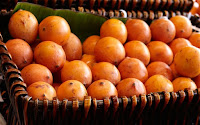Apple cider vinegar (ACV) is my new obsession. I recently began taking ACV shots a few times a day for a quick and effective energy burst. However, I've since discovered so many other useful ways to incorporate ACV into my daily routine.
It's effective for pretty much anything — your skin, your hair, your house, and even your pets can benefit from its qualities. Raw,organic , unfiltered, and unpasteurized, ACV is so much more than a salad dressing!
1. ACV can detoxify your home.
It's made from apple juice and is fermented to hard apple cider. It's then fermented a second time to become apple cider vinegar. By using ACV in lieu of other products, we instantly decrease the consumption of unnatural chemicals in our homes and daily lives.
2. It can make your hair shine.
Apple cider vinegar can be used as a rinse for your hair after shampooing, and it will boost your hair's body and shine. I recommend recycling an old shampoo bottle, then filling it with ½ tablespoon of ACV and 1 cup of cold water. Pour the solution through your hair after shampooing. Do this several times a week for dramatic results.
3. Natural ACV regulates the pH of your skin.
Dilute ACV with two parts water, and spread the concoction over your face with a cotton ball to replace your current toner. You can do this at night after washing, and in the morning before you apply your moisturizer. A dab of ACV can also be left on the skin overnight to fade age spots or acne scars.
It's also a recommended agent for warts. For warts, soak a cotton ball in ACV, then fasten the cotton ball over the wart with a Band-Aid overnight. The skin may swell some as it reacts with the solution. However, the wart will fall off. Once it falls off, the treatment should be continued for a few more days, to make sure the wart doesn't return.
4. It can remove stains from teeth.
Rub teeth directly with apple cider vinegar, and rinse with water.
5. It can soothe sunburned skin.
Add 1 cup of apple cider vinegar to your bath, and soak for 10 minutes to eliminate discomfort from sunburn.
6. ACV can be used as a natural aftershave.
Fill a bottle with equal parts apple cider vinegar and water, and shake before applying to the face.
7. It's an all-natural massage treatment.
Rubbing apple cider vinegar on your hands and feet will give massage-like benefits and relief to tired hands and feet.
For daily weight management, add 2 teaspoons of apple cider vinegar to 16 ounces of water. This concoction can be sipped throughout the day. Data shows some limited, yet significant, weight-loss benefits from sustained daily intake of acetic acid (which is a main ingredient in ACV).
In a 2009 study published in Bioscience, Biotechnology, and Biochemistry, it was found that subjects who consumed acetic acid for 12 weeks experienced significant declines in body weight, abdominal fat, waist circumference, and triglycerides. Triglycerides contribute to the bad cholesterol that we want to avoid.
9. ACV will balance your entire inner body system.
The body constantly strives to achieve a state of equilibrium. Apple cider vinegar helps the body maintain a healthy alkaline pH level. Research shows that higher acid levels (lower pH level) lead to a lack of energy and higher incidences of infection. Hence, my desire to sip some a few times a day for a natural boost of energy.
10. It can help you detox.
As part of balancing the body's pH, ACV creates an overall detoxification of the body. Research shows that it can help stimulate cardiovascular circulation and help detoxify the liver.
11. ACV is great for your lymphatic system.
This miracle vinegar helps to break up mucus throughout the body and cleanse the lymph nodes. Believe it or not, research suggests that ACV can help with allergies because of its ability to reduce mucus and sinus congestion. When reducing the effects of allergies, it can also help stave off sinus infections and their related symptoms, such as sore throats and headaches.
12. It can help your body get rid of candida.
This vinegar is rich in natural enzymes that can help rid your body of candida — yeasts that are attributed to thrush in humans. Candida is also blamed for creating symptoms of fatigue, poor memory, sugar craving, and yeast infections.
13. ACV can help you reduce heartburn.
Though it might seem like an oxymoron to treat stomach acid with an acid-containing vinegar, there is research suggesting that apple cider vinegar works by correcting low acid, hence reducing heartburn. Natural remedy experts say you should begin to feel relief very shortly after taking 1 teaspoon of ACV followed by a glass of water. Note that ACV will not give relief if you have an ulcer.
14. The use of ACV is effective in repelling fleas on your pets.
One part vinegar and one part water can be sprayed on your pets' fur and rubbed in generously to the skin. Saturate the entire coat, and continue every day for a few days to a week. Any flea infestation will surely be gone.
15. It's an all-natural room freshener.
ACV will clean your toilets and leave your bathroom smelling like apples! Just pour ACV into the toilet, and allow it to sit overnight. It can also be used in dishwashers as a substitute for dish detergent. Mix ½ cup of ACV with 1 cup water, and you can use this solution to clean microwaves, kitchen surfaces, windows, glasses, and mirrors, too.
















